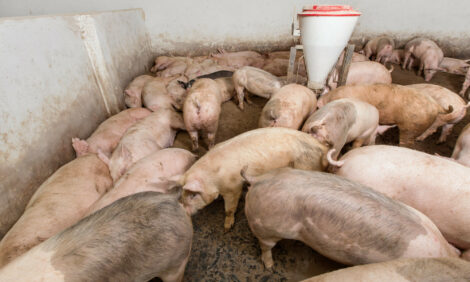



Infectious Agents Associated with Respiratory Diseases in 125 Farrow-to-finish Pig Herds
A cross-sectional study was carried out in 125 farrow-to-finish pig herds in France to assess the relationships between pathogens involved in respiratory disorders as well as pneumonia and pleuritis at slaughter.Key Messages
- 125 farrow-to-finish herds in France (Brittany, Normandy and Pays de la Loire) were sampled for respiratory agents and lesions.
- PRRSV antibodies were detected in 60 per cent [51.2–68.8 per cent] of the herds.
- PRRSV and Actinobacillus pleuropneumoniae st2 (App) were significantly associated with pneumonia-like lesions and pleuritis.
- PRRSV presence was positively correlated with higher pneumonia scores at the slaughterhouse and to higher incidence of pleuritis.
- Infection before 10 weeks of age caused the higher odds of having high pneumonia-like lesions score while infection after 10 weeks was associated with the higher odds of having pleuritis.
Article Brief
A cross sectional study was carried out in 125 farrow-to-finish pig herds to assess the relationships between pathogens involved in respiratory disorders and to relate these findings to clinical signs of respiratory diseases and pneumonia and pleuritis at slaughter.
Mycoplasma hyopneumoniae, Actinobacillus pleuropneumoniae, swine influenza viruses (SIV), porcine reproductive and respiratory syndrome virus (PRRSV) and porcine circovirus type 2 (PCV2) were detected by serological or PCR tests, in each herd pigs aged four, 10, 16 and 22 weeks. Slaughterhouse examinations were performed one to three weeks after the sampling in the 22-week old pigs of each batch.
Pigs with antibodies against PRRSV at 10, 16 and 22 weeks and against M. hyopneumoniae at 22 weeks were positively correlated with the percentage of pigs with antibodies against A. pleuropneumoniae serotype 2 and SIV H1N1 and SIV H1N2 sero-positive pigs.
A. pleuropneumoniae serotype 2 and PRRSV infections during the finishing phase significantly increased the odds for a batch to have at least one pig with extensive pleuritis.
The main microorganisms associated with respiratory diseases are widespread in western France, and are probably interacting. PRRSV antibodies were detected in 60 per cent (51.2 to 68.8 per cent) of the 125 herds tested and the presence of PRRSV was significantly associated with pneumonia-like gross lesions.
One cluster of 33 herds was identified by a high pneumonia-like gross lesions and a high level of coughing at 16 weeks of age (6.5 coughs per 100 pigs versus 3.6 coughs per 100 pigs in the general sample) as well as a higher percentage of pigs with congested tracheo-bronchial lymph nodes (16.8 per cent versus 12.2 per cent).
This cluster had a higher percentage of pigs with antibodies against PRRSV at 10 weeks (51.7 per cent versus 19.8 per cent), 16 (93.6 per cent versus 37.6 per cent) and 22 weeks (96.5 per cent versus 54.0 per cent) than the general sample.
M. hyopneumoniae and SIV subtype H1N1 are the major pathogens involved in pneumonia, although PCV2 may play a role, whereas A. pleuropneumoniae serotype 2 is significantly associated with pleuritis. The development and severity of both lung diseases is influenced by PRRSV infection.

Reference
Fablet C., Marois-Créhan C., Simon G., Grasland B., Jestin A., Kobisch M., Madec F. and Rose. N. 2012. Infectious agents associated with respiratory diseases in 125 farrow-to-finish pig herds: A cross-sectional study. Vet. Microbiol. May 25, 2012. 157(1-2):152-63. Epub 2011 Dec 19.
Find out more information about Prevalence here
Find out more information about Interaction With Other Pathogens here
October 2015









